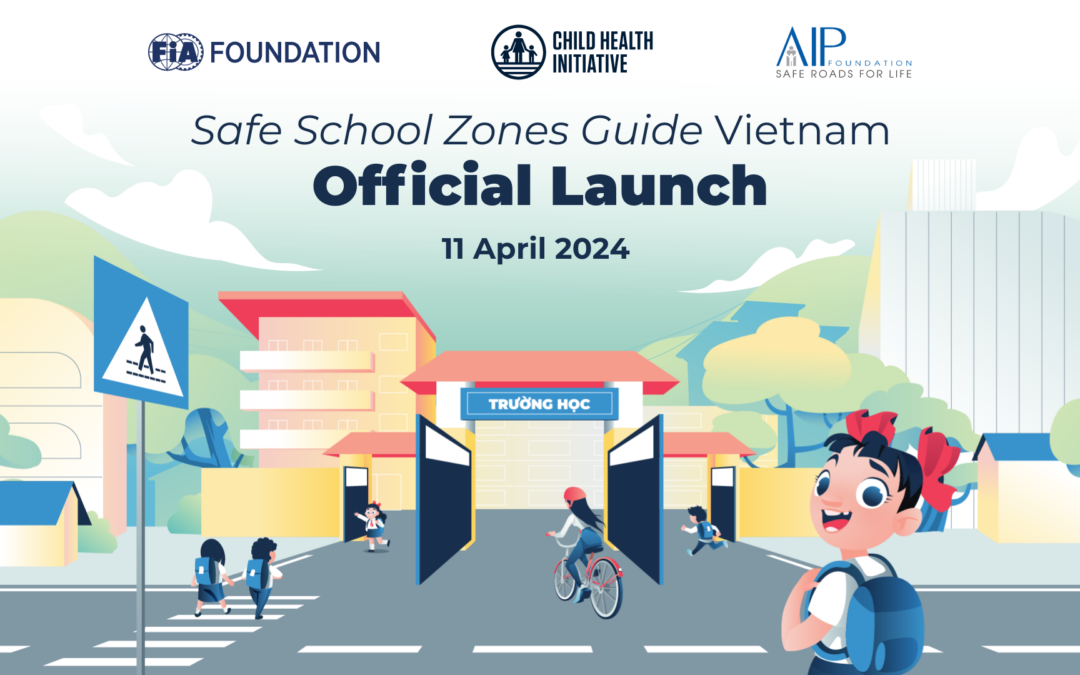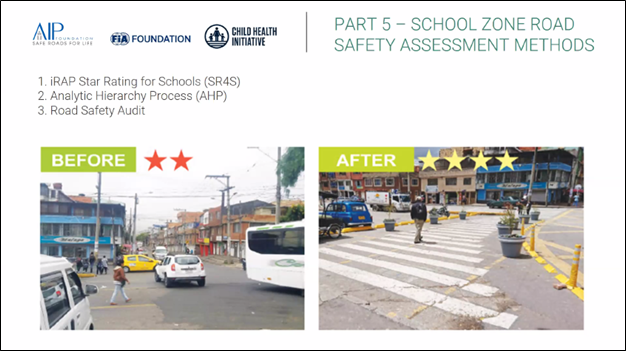दुनिया भर में बच्चों को सड़कों पर बहुत ज़्यादा खतरों का सामना करना पड़ता है, खास तौर पर स्कूल आते-जाते समय। अकेले वियतनाम में, नेशनल ट्रैफ़िक सेफ्टी कमेटी के आँकड़े बताते हैं कि 2021 में 18 साल से कम उम्र के बच्चों की वजह से सड़क दुर्घटनाएँ हुईं, जिनमें से 10.63% दुर्घटनाएँ हुईं। 17 मिलियन से ज़्यादा बच्चे रोज़ाना 2-4 बार घर और स्कूल के बीच आते-जाते हैं, इसलिए उनके स्कूल के सफ़र के लिए सड़क सुरक्षा उपायों को बढ़ाना बहुत ज़रूरी होता जा रहा है।
एआईपी फाउंडेशन, जो एसआर4एस का प्रमुख भागीदार है, 2005 से वियतनाम में स्कूल क्षेत्र की सुरक्षा में सुधार के लिए सक्रिय रूप से शामिल रहा है। धीमे क्षेत्र, सुरक्षित क्षेत्र कार्यक्रम, अंतर्राष्ट्रीय केस स्टडीज के साथ, एआईपी फाउंडेशन, के साथ साझेदारी में परिवहन एवं संचार विश्वविद्यालय (यूटीसी), थे वियतनाम समाजवादी गणराज्य का परिवहन मंत्रालय (MOT), और यह 1 टीपी 6 टीने सुरक्षित स्कूल क्षेत्र गाइड (एसएसजेड गाइड) विकसित की है।
गाइड के विकास के लिए तकनीकी सहायता प्रदान की गई। वैश्विक सड़क सुरक्षा साझेदारी और यह 1टीपी1टी (1टीपी4टी). इस वर्ष की शुरुआत में, परिवहन मंत्रालय (MOT) को पहली बार SSZ गाइड की औपचारिक प्रस्तुति के साथ एक महत्वपूर्ण मील का पत्थर हासिल किया गया। इसके अतिरिक्त, गाइड का अंग्रेजी संस्करण इसे वैश्विक दर्शकों के सामने पेश करने के लिए आधिकारिक तौर पर 11 अप्रैल, 2024 को लॉन्च किया गया।
SSZ गाइड को विभिन्न स्कूल जोन-संबंधित परियोजनाओं में शामिल हितधारकों का समर्थन करने के लिए तैयार किया गया है। चाहे वह नए स्कूलों का निर्माण हो, मौजूदा स्कूलों में संशोधन हो, स्कूल जोन के पास सड़क निर्माण या उन्नयन हो, या स्कूल निवेश, नए निर्माण और नवीनीकरण परियोजनाओं से संबंधित सुरक्षा आकलन हो, यह गाइड एक मूल्यवान संसाधन के रूप में कार्य करता है। जबकि गाइड के भीतर डिज़ाइन मानक वियतनाम के नियमों का पालन करते हैं, इसकी परिभाषाएँ, व्यापक योजना और डिज़ाइन सिद्धांत, और स्कूल ज़ोन के लिए आवश्यक ट्रैफ़िक अवसंरचना सड़क इंजीनियरों, नीति निर्माताओं और दुनिया भर के प्रासंगिक क्षेत्रों में संस्थाओं को मूल्यवान अंतर्दृष्टि प्रदान कर सकती है।
एसएसजेड गाइड में कई प्रमुख खंड शामिल हैं जिनका उद्देश्य स्कूल क्षेत्रों में सड़क सुरक्षा को बढ़ाना है:
- भाग 1 में परिचय दिया गया है, जिसमें गाइड के उद्देश्यों, लक्षित दर्शकों और प्रयोजनों की रूपरेखा दी गई है।
- भाग 2 में स्कूल क्षेत्रों में सड़क यातायात सुरक्षा का अवलोकन प्रस्तुत किया गया है, शब्दों की परिभाषा दी गई है तथा बच्चों के लिए प्रमुख जोखिमों पर प्रकाश डाला गया है, साथ ही सुरक्षित स्कूल क्षेत्र के आदर्श मॉडल प्रस्तुत किए गए हैं।
- भाग 3 में विभिन्न नियोजन संदर्भों में सुरक्षा मानकों को पूरा करने के लिए स्कूल क्षेत्रों की योजना बनाने के बुनियादी सिद्धांतों पर चर्चा की गई है।
- भाग 4 में सुरक्षित स्कूल क्षेत्रों के डिजाइन पर विस्तार से चर्चा की गई है, जिसमें सिद्धांतों, सुधार कदमों और सड़क सुरक्षा बढ़ाने के लिए तकनीकी उपायों को शामिल किया गया है।
- भाग 5 में स्कूल क्षेत्रों में सड़क सुरक्षा का आकलन करने के तरीकों का परिचय दिया गया है, तथा स्कूल क्षेत्र नियोजन और प्रबंधन में शामिल हितधारकों के लिए एक व्यापक रूपरेखा प्रदान की गई है।
SSZ गाइड स्कूल क्षेत्रों में सड़क सुरक्षा मूल्यांकन की एक विधि के रूप में SR4S की सिफारिश करता है, क्योंकि यह स्वचालित और उच्च सटीकता वाला है। वस्तुनिष्ठ परिणाम प्रदान करके, SR4S मूल्यांकनकर्ताओं द्वारा व्यक्तिपरक मूल्यांकन की आवश्यकता को कम करता है। इसके अलावा, प्रशिक्षित सर्वेक्षणकर्ताओं द्वारा किए गए मूल्यांकन परिणामों की विश्वसनीयता को बढ़ाते हैं। SR4S को वियतनाम में विभिन्न परियोजनाओं में नियोजित किया गया है, जिसमें SSZ गाइड के लिए पायलट अध्ययन और अन्य पहल शामिल हैं इस तरह से चलें, धीमे क्षेत्र, सुरक्षित क्षेत्र, AI&Me: सुरक्षित सड़कों के लिए युवाओं को सशक्त बनाना, देश भर में 200 से अधिक स्कूलों का मूल्यांकन किया गया।


